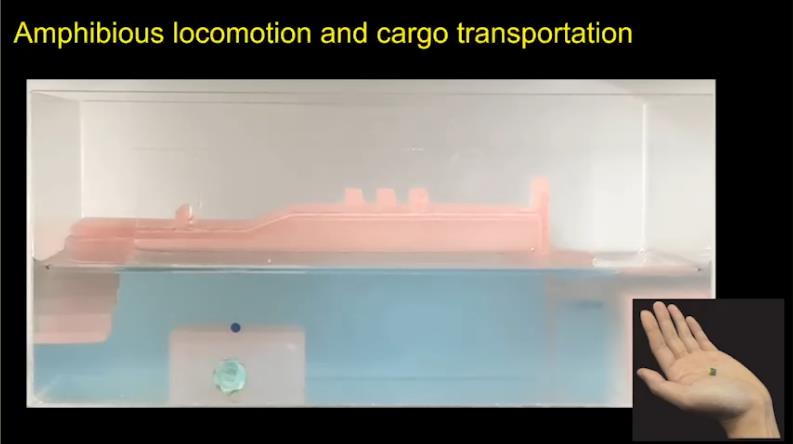创新背景
几十年来,非处方药已经治愈了许多疾病,但生物医学研究人员直到最近才开始探索在治疗心血管疾病或癌症等更复杂的疾病时改善靶向给药的方法。
在这个新兴的生物医学领域,一个有前途的创新是微型机器人。这些指尖大小的机器人将成为医学未来的救星——通过爬行、旋转和游泳进入狭窄的空间,完成研究内部工作原理或分发药物的任务。
创新过程
斯坦福大学机械工程师Renee Zhao是这一领域的领军人物,她同时致力于许多微型机器人的设计——包括一个磁爬行机器人,最近在《科学进展》杂志的封面上看到它从胃部蠕动而过。她的机器人由磁场提供动力,可以进行连续的运动,并立即产生扭矩,改变机器人的运动方式。她的机器人可以自行选择不同的火车头状态,克服身体上的障碍。仅仅通过改变磁场的强度和方向,赵的团队就可以让机器人在10倍于自身长度的距离内飞跃身体。她的研究的一个关键方面是,磁驱动还为无创操作提供非栓系控制,并将控制单元与设备分离,以实现小型化。

这种新型的“可旋转的无线两栖折纸微型机器人”就像它的名字所暗示的那样多功能。这是一个设计优雅的单一单元,能够在器官光滑不平的表面上快速移动,并在体液中游动,在运输液体药物时通过无线方式推动自己。机械工程助理教授赵说,与吞下的药片或注射的液体不同,这个机器人保留药物,直到它到达目标,然后释放高浓度的药物。
重塑药物输送
这种特殊的两栖机器人的突破性之处在于,它超越了大多数基于折纸的机器人的设计,后者仅利用折纸的可折叠性来控制机器人的变形和移动。
在研究折叠如何使机器人执行某些动作的基础上——想象一下手风琴式的折叠可以挤压出药物——赵的团队还考虑了在没有折叠时,每个折叠的精确形状的尺寸如何影响机器人的刚性运动。因此,机器人的展开形式天生适合通过环境推进。这种广泛的考虑使得研究人员能够在不增加体积的情况下更多地利用这些材料——在赵的世界里,机器人设计的单一结构实现的功能越多,医疗过程的侵入性就越小。

机器人设计的另一个独特之处是结合了某些几何特征。机器人的中心有一个纵向的洞,两侧有倾斜的侧缝,减少了水的阻力,帮助机器人更好地游泳。这种设计在机器人体内诱导了一种负压,以便快速游泳,同时为货物的拾取和运输提供了吸力。研究人员充分利用了这个小型机器人的几何特征,并探索单一结构的不同应用和不同功能。
创新价值
该微型机器人将不仅为有效配药提供方便的方式,还可以用于携带仪器或摄像头进入身体,改变医生检查病人的方式。
创新关键点
这种新型的“可旋转的无线两栖折纸微型机器人”就像它的名字所暗示的那样多功能。这是一个设计优雅的单一单元,能够在器官光滑不平的表面上快速移动,并在体液中游动,在运输液体药物时通过无线方式推动自己。
Micro-robots are being developed to make targeted drug delivery more precise
Renee Zhao, a mechanical engineer at Stanford University who is leading the field, is simultaneously working on the design of many tiny robots - including a magnetic crawling robot recently seen on the cover of the journal Science Advances wriggling through a stomach. Her robot is powered by a magnetic field that allows it to move in continuous motion and instantly generates torque that changes the way the robot moves. Her robot can choose different locomotive states and overcome physical obstacles. Just by changing the strength and direction of the magnetic field, Zhao's team can get the robot to leap over its body over a distance 10 times its own length. A key aspect of her research is that magnetic actuation also provides non-tethered control for non-invasive operations and separates the control unit from the device for miniaturization.
The new "rotatable wireless amphibious origami miniature robot" is as versatile as its name suggests. It's an elegantly designed single unit capable of moving quickly across smooth, uneven surfaces of organs and swimming through body fluids, propelling itself wirelessly as it delivers liquid medicine. Zhao, an assistant professor of mechanical engineering, said that unlike a pill swallowed or liquid injected, this robot retains the drug until it reaches its target, and then releases a high concentration of the drug.
Reshaping drug delivery
What is groundbreaking about this particular amphibious robot is that it goes beyond the design of most origami-based robots, which only use the foldability of the origami to control the deformation and movement of the robot.
On the basis of studying how folding allows the robot to perform certain actions - imagine accordion-style folding squeezing out drugs - Zhao's team also considered how the size of the precise shape of each fold affects the rigid motion of the robot in the absence of folding. Thus, the unfolding form of the robot is naturally suited to propulsion through the environment. This broad consideration allows researchers to make more use of these materials without adding bulk - in Zhao's world, the more functions a single structure designed by a robot can achieve, the less invasive the medical procedure will be.
Another unique feature of the robot design is the incorporation of certain geometric features. There is a longitudinal hole in the center of the robot with slanted side slits on both sides, which reduces water resistance and helps the robot swim better. This design induces a negative pressure inside the robot for fast swimming while providing suction for cargo pickup and transport. The researchers took full advantage of the small robot's geometric features and explored different applications and different functions of a single structure.
智能推荐
肿瘤学创新 | 创新利用“磁性细菌”可穿过血管壁对抗肿瘤
2022-10-28苏黎世联邦理工学院的研究人员研究了一种新方法,可使用磁性细菌来对抗癌性肿瘤。
涉及学科涉及领域研究方向新型无线电波设备可通过监测呼吸数据识别帕金森患者
2022-09-07涉及学科涉及领域研究方向使用线粒体靶向抗生素或能治疗黑色素瘤
2022-08-14利用线粒体对抗生素的反应,开发线粒体靶向抗生素实验治疗黑色素瘤。
涉及学科涉及领域研究方向血液病学创新 | 创新细胞疗法可提高骨髓移植的安全性
2022-11-10研究人员发现,利用T细胞进行细胞疗法可以减少和延迟移植细胞对健康组织的攻击,而不影响这些细胞的抗癌能力。
涉及学科涉及领域研究方向